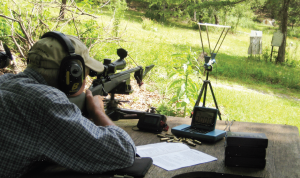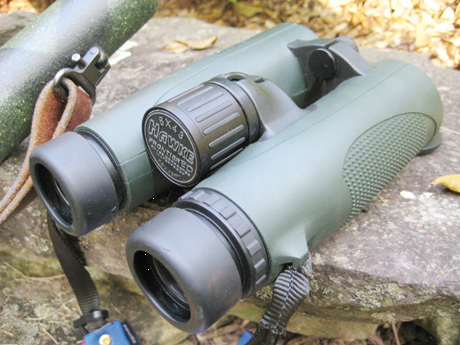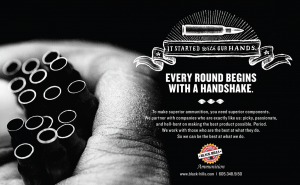by John Markwell | Contributing Editor
A new chronograph has emerged on the shooting scene that we have found to be incredibly convenient. The MagnetoSpeed V2 Ballistic Chronograph (9206 Rod Rd., Suite C, Dept. TGM, Austin, TX 78736; phone: 512- 284-8161; online: MagnetoSpeed.com) is a barrel mounted unit that eliminates the long wires, tripods, and sky screens associated with most chronographs that we know of. Also, the MagnetoSpeed unit is not dependent on just the right lighting conditions in order to function. It is one pretty cool piece of shooting gear. What follows is our evaluation of the MagnetoSpeed V2 chronograph. After using it for a few months now, we like this unit a lot.
The V2 uses patent pending magnetic sensor technology, which senses the bullet’s passing to trigger the unit’s start-stop function and thus giving us the bullet’s speed. (That’s the best we can do on the technical stuff). The V2 works in any light conditions.
As mentioned, the MagnetoSpeed V2 is a barrel mounted unit similar to a bayonet. The “Bayo Unit Assembly” incorporates both the sensor unit (the “sensor deck”) and the V-block mounting system. Using a series of spacers, rubber pads and a nylon tensioning strap, the V-block assembly allows attachment of the V2 to barrels ranging in diameter from ½ inch through 2 inches. Included in the compact plastic case with the V2, is an alignment rod for making sure the sensor deck is properly oriented below the weapon’s bore line. This is critical to the proper functioning of the unit as well as ensuring the sensor deck is not damaged by a fired bullet.

The author at his bench testing loads over both the MagnetoSpeed V2 and his CED chronograph simultaneously.
We should mention that the V2 will not work on handguns with reciprocating slides such as 1911s or S&W M&Ps.
It will work on any firearm with a fixed barrel. Revolvers and single shot handguns are compatible with the V2, as are shotguns. Also the V2 is usable with barrels incorporating muzzle brakes and suppressors (if two inches and under in diameter).
When a bullet is fired across the Bayo unit’s sensor deck, the bullet speed is transmitted to the V2’s shirt pocket sized Display Unit which is powered by four AAA batteries and is connected to the Bayo Unit by either of the two included connector cables (one on a retractor). The Data Display Unit shows the number and velocity of the individual shots, maximum and minimum velocities in either feet per second (default) or meters per second, the average velocity, standard deviation and extreme spread. The Display Unit has a capacity of 99 shots and a volume of data can be stored on the enclosed microSD card.
The V2 works with all types of projectiles but requires some minor programming or “tuning” for some to be detected when passing over the sensor deck. Traditional copper+lead core bullets, copper+steel core bullets, and shotgun slugs are all easily chronographed with the V2, while shot loads require tuning the unit’s sensitivity by using the “custom trigger” function in the menu.
We first mounted the MagnetoSpeed V2 on my son’s American Precision Arms 7mm-08 tactical bolt gun with its muzzle brake. We figured we might as well give the V2’s Bayo Unit the toughest treatment first. Alignment with the rifle’s bore involved a bit of fiddling with the assorted spacers but was accomplished in short order. This barrel mounting process of the V2 was definitely simpler and quicker than setting up our Competitive Edge Dynamics (CED) M2 Chronograph. The V2’s installation on the rifle’s barrel was done right at the bench and involved no trips down range for leveling and alignment. This “at-thebench” set up would be a great convenience for those who use a public range. The blast of the APA muzzle brake had no effect on the V2’s reading the velocity of the 7mm 162-grain Hornady A-Max bullets from Brock’s rifle. As expected, the velocities were just a bit higher than those previously obtained with our CED unit since they were measured at the muzzle instead of ten feet down range.
A note on alignment of the V2’s sensor deck with the bore: make sure the gun is unloaded and then be sure to check the alignment from both the side at the muzzle and through the breach end of the barrel to make sure bullets will clear the deck.
Some time later, we mounted the MagnetoSpeed V2 on a FNH Tactical Sporting Rifle in caliber .223 Remington. Up at our bench, we set up our CED chronograph at the standard 10- foot distance and shot 13 different loads through the V2 and the CED simultaneously to see what the differences might be. Every load clocked faster over the V2 at the muzzle than over the CED 10 feet out.
Mk262 5.56 ammo loaded with Sierra’s 77-gr. HPBT Match bullet showed the least variance with only 6fps difference between the V2 and the CED unit. The other loads had a difference ranging from 10 to 15fps with Nosler’s 40-gr lead free Ballistic tip load showing the greatest difference at 46fps. This doesn’t seem like a lot of variance but for those shooting at long range even small deviations in velocity are important, especially out at 1,000 yards and beyond. We think getting a true muzzle velocity will be of great benefit to long range shooters as well as others interested in producing precision hand loads.
It should be noted that hanging the V2 on a rifle’s barrel can affect its point of impact and grouping. However, we found the barrel mounted V2 to be so convenient for load development that this is of no concern to us. In fact we used the V2 while working up a load recently and just walked out on the deck and launched bullets into the ground to get velocities; no trips up to the bench to just shoot 3 or four rounds at a time as we worked on the load.
If you are in the market for a new chronograph or especially if you use one at a public range a lot, the MagnetoSpeed is definitely worth a look. It is compact, accurate, easy to set up at the bench and is not light sensitive. With an MSRP of $375, the V2 MagnetoSpeed chronograph is pretty much inline price-wise with other units on the market. It is, however, the only chronograph, we are aware of, that gives the shooter a true muzzle velocity. We think you’ll be seeing more of these MagnetoSpeed V2s showing up at your local range in the future, as it is, in our opinion, truly a better mouse trap.
Hawke ED Binoculars Binoculars have come a long way in recent years. There was a time when really good glasses were pretty much beyond the reach of the average sportsman and even today many folks find the price of some of the high-end binoculars on the market pretty hard to swallow.

The Hawke Sport Optics Frontier ED binoculars have a good gripping surface molded into the rubber armor covering and very good lens caps.
While working in a hunting camp in Wyoming, we had the opportunity, over several years, to compare, side by side, quite a few different binoculars. We would take the different glasses hunters brought to camp, and line them up on a hitching rail and look across a meadow at the dark timber on the other side. Our conclusion was as follows and is purely our opinion based on this limited and unscientific field testing. We found most of the lower priced binoculars hunters brought to camp, those generally under a couple of hundred dollars at retail, lacked the resolution and light gathering capabilities to be really useful in the lower light conditions of mornings and evenings; like when the elk were moving. Those glasses we were able to use which were in the mid-range price wise, from about $400 thru around $1,000, were all pretty good; and most were noticeably better in the clarity, color resolution and light gathering departments than the lower priced models, or so it seemed to us. Most of the glasses in this second category allowed one to see back into the dark timber and were pretty usable as evening light faded.
The really high end binoculars, and we all know the brands, were, quite frankly, better than the others in all respects. However, we had to ask ourselves were they $1,500 to $2,000 better? I say maybe. My son says if you make your living using binoculars, as he did when guiding for elk, these high end glasses are a good investment. And, for the well-heeled they are the obvious way to go. So, where is this going? We have recently been using the Frontier ED 8 x 43 binoculars from Hawke Sport Optics (6015 Highview Dr., Suite G, Dept TGM, Fort Wayne, IN 46818; phone: 877-429-5347: online: hawkeoptics.com). These Chinesemade, green rubber armored glasses fall into our self-established mid-price range with an MSRP of $529.99.
Designed around extra-low dispersion (ED) glass with phase-corrected BAK4 prisms, the Frontier ED binoculars provide sharp images with brilliant color resolution. In fact, the latter is as intense as most high-end binos we’ve looked through. Watching hummingbirds at my wife’s feeders, we were stunned by the brilliance of the birds’ feathers when viewed through the Hawke Frontier EDs. The optical quality of these glasses was way better than their moderate price would lead one to expect. The Frontier’s field of view at 100 yards is 426 feet which makes acquiring a target quick and easy. For close viewing, the Frontiers will focus down to 6.6 feet with no loss in clarity.
At 26.2 ounces and 6¾ inches in length, the Frontier binoculars are a bit bigger and heavier than we prefer for hunting here in the mountains but their brightness offsets any weight disadvantage. The Frontier ED binocular comes with good lens covers, twist up eye cups to adjust eye relief, and a nicely padded carrying case and lens cloth. The neck strap provided is nicely padded but, as is our habit, we replaced it with one made of nylon webbing which slides over clothing more easily. Lastly, the Frontier Binoculars are nitrogen purged and waterproof “in normal conditions, but are not designed to be immersed in water.” The Hawke Frontier ED binoculars are covered by a limited lifetime warranty.
We have been using these Hawke binoculars for about two months now and have put in considerable time with them. We spent a goodly amount of time glassing for woodchucks during the late summer and we, and others, used them for three solid days at the Fall Allegheny Sniper Challenge for spotting on close, steel targets. Our opinion is that the Frontier ED Binoculars from Hawke Optics represent a pretty good bargain. For a mid-priced optic, the Frontier ED binos provide quality images, excellent color and brightness and, most importantly, are easy on the eyes when used for long periods of time in the field. We have yet to abuse the Hawke Frontier HDs with exposure to severe weather conditions, but with the Fall hunting season looming, it is just a matter of time before we see how they will hold up to the rigors of hunting here in the Alleghenies.
So, there you have it. With the holidays just around the corner, we feel any shooter in your family would be happy to find either a new MagnetoSpeed Chronograph or a pair of Frontier HD binoculars from Hawke Sport Optics under the tree on Christmas morning. Either would make a great gift for the outdoors person on your list. Merry Christmas and, good shooting.




